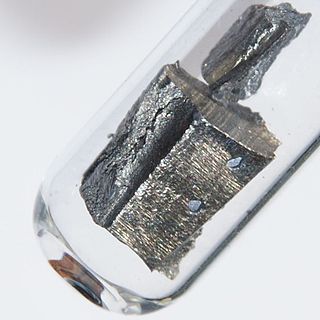The lanthanide or lanthanoid series of chemical elements comprises at least the 14 metallic chemical elements with atomic numbers 57–70, from lanthanum through ytterbium. In the periodic table, they fill the 4f orbitals. Lutetium is also sometimes considered a lanthanide, despite being a d-block element and a transition metal.

Neodymium is a chemical element; it has symbol Nd and atomic number 60. It is the fourth member of the lanthanide series and is considered to be one of the rare-earth metals. It is a hard, slightly malleable, silvery metal that quickly tarnishes in air and moisture. When oxidized, neodymium reacts quickly producing pink, purple/blue and yellow compounds in the +2, +3 and +4 oxidation states. It is generally regarded as having one of the most complex spectra of the elements. Neodymium was discovered in 1885 by the Austrian chemist Carl Auer von Welsbach, who also discovered praseodymium. It is present in significant quantities in the minerals monazite and bastnäsite. Neodymium is not found naturally in metallic form or unmixed with other lanthanides, and it is usually refined for general use. Neodymium is fairly common—about as common as cobalt, nickel, or copper and is widely distributed in the Earth's crust. Most of the world's commercial neodymium is mined in China, as is the case with many other rare-earth metals.
Neodymium(III) chloride or neodymium trichloride is a chemical compound of neodymium and chlorine with the formula NdCl3. This anhydrous compound is a mauve-colored solid that rapidly absorbs water on exposure to air to form a purple-colored hexahydrate, NdCl3·6H2O. Neodymium(III) chloride is produced from minerals monazite and bastnäsite using a complex multistage extraction process. The chloride has several important applications as an intermediate chemical for production of neodymium metal and neodymium-based lasers and optical fibers. Other applications include a catalyst in organic synthesis and in decomposition of waste water contamination, corrosion protection of aluminium and its alloys, and fluorescent labeling of organic molecules (DNA).

Dysprosium acetylacetonate is a chemical compound of dysprosium with formula Dy(C5H7O2)3(H2O)n.

Europium acetylacetonate is a coordination complex with formula Eu(C5H7O2)3. Although this anhydrous acetylacetonate complex is widel discussed, some sources suggest that it is really the dihydrate Eu(C5H7O2)3(H2O)2.

Gadolinium acetylacetonate is a coordination compound with the formula Gd(C5H7O2)3. This anhydrous acetylacetonate complex is widely discussed but unlikely to exist per se. The 8-coordinated dihydrate Gd(C5H7O2)3(H2O)2 is a more plausible formula based on the behavior of other lathanide complexes. It has also been characterized twice by X-ray crystallography.

Neodymium(III) bromide is an inorganic salt of bromine and neodymium the formula NdBr3. The anhydrous compound is an off-white to pale green solid at room temperature, with an orthorhombic PuBr3-type crystal structure. The material is hygroscopic and forms a hexahydrate in water (NdBr3· 6H2O), similar to the related neodymium(III) chloride.

Neodymium nitrate is a chemical compound with the formula Nd(NO3)3. It is typically encountered as the hexahydrate, Nd(NO3)3·6H2O, which is more accurately formulated as [Nd(NO3)3(H2O)4].2H2O to reflect the crystal structure. It decomposes to NdONO3 at elevated temperature. This water-soluble salt finds use in fabrication of perovskite (CaTiO3) based solid oxide fuel cells, synthesis of Nd3+ doped vanadium pentoxide (V2O5) nanostructure for potential usage in supercapacitors and as a catalyst for Friedlander synthesis of surface modified quinolones for application in medicinal chemistry.
Neodymium(III) iodide is an inorganic salt of iodine and neodymium with the formula NdI3. Neodymium uses the +3 oxidation state in the compound. The anhydrous compound is a green powdery solid at room temperature.

Neodymium compounds are compounds formed by the lanthanide metal neodymium (Nd). In these compounds, neodymium generally exhibits the +3 oxidation state, such as NdCl3, Nd2(SO4)3 and Nd(CH3COO)3. Compounds with neodymium in the +2 oxidation state are also known, such as NdCl2 and NdI2. Some neodymium compounds have colors that vary based upon the type of lighting.
Neodymium(III) sulfide is a inorganic chemical compound with the formula Nd2S3 composed of a two neodymium atoms in the +3 oxidation state and three sulfur atoms in the +2 oxidation state. Like other rare earth sulfides, neodymium(III) sulfide is used as a high-performance inorganic pigment.

Neodymium(II) iodide or neodymium diiodide is an inorganic salt of iodine and neodymium the formula NdI2. Neodymium uses the +2 oxidation state in the compound.
An iodide nitride is a mixed anion compound containing both iodide (I−) and nitride ions (N3−). Another name is metalloiodonitrides. They are a subclass of halide nitrides or pnictide halides. Some different kinds include ionic alkali or alkaline earth salts, small clusters where metal atoms surround a nitrogen atom, layered group 4 element 2-dimensional structures, and transition metal nitrido complexes counter-balanced with iodide ions. There is also a family with rare earth elements and nitrogen and sulfur in a cluster.

Holmium acetylacetonate is a coordination complex, with the chemical formula of Ho(C5H7O2)3 or Ho(acac)3. It can be obtained via the reaction between metallic holmium or holmium(III) hydride with acetylacetone, or via the reaction between holmium(III) chloride and ammonium acetylacetonate. Its anhydrous form is stable in a dry atmosphere but forms a hydrate in humid air.

Lanthanum(III) iodide is an inorganic compound containing lanthanum and iodine with the chemical formula LaI
3.

Praseodymium acetylacetonate is a coordination complex with the formula Pr(C3H7O2)3. This purported anhydrous acetylacetonate complex is widely discussed but only the dihydrate Pr(C3H7O2)3(H2O)2 has been characterized by X-ray crystallography.

Erbium acetylacetonate is a coordination compound, with the chemical formula of Er(C5H7O2)3, or Er(acac)3 for short.

Lanthanum acetylacetonate refers to the coordination complex with the formula La(C5H7O2)3. This anhydrous acetylacetonate complex has not been characterized well, but the dihydrate La(C5H7O2)3(H2O)2 has been characterized by X-ray crystallography.

Lutetium acetylacetonate is a coordination compound with the chemical formula Lu(C5H7O2)3, or Lu(acac)3 for short. It is isomorphic to ytterbium acetylacetonate. It can be prepared by the reaction of trialkoxylutetium and acetylacetone.













